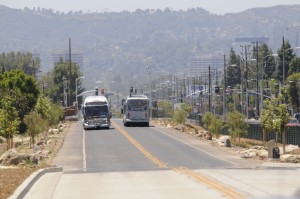So says a new study by researchers Jesper Ingvardson and Otto Nielsen from the Technical University of Denmark, as reported by The City Fix:
Ingvardson and Nielsen compare 86 metro, light rail transit (LRT) and bus rapid transit (BRT) corridors using several variables: travel time savings, increase in demand from riders, modal shift, and land use and urban development changes. In some cases, the much more economical BRTs matched and even outperformed rail.
The key for buses to match or exceed all of these major benefits of rail is to have “buses done right.” That means bus rapid transit in its own dedicated lanes, with fast boarding and frequent service.
The benefits for transit advocates and the public are huge: bus rapid transit is far cheaper than rail (often 1/5 the price) and can get built much more quickly (sometimes in 1/5 the years).
To be sure, rail is appropriate in densely populated environments and travel corridors. But most cities in the United States have many more moderate-density corridors than high-density ones. In these areas, the case for true bus rapid transit is looking more and more like a no-brainer.



